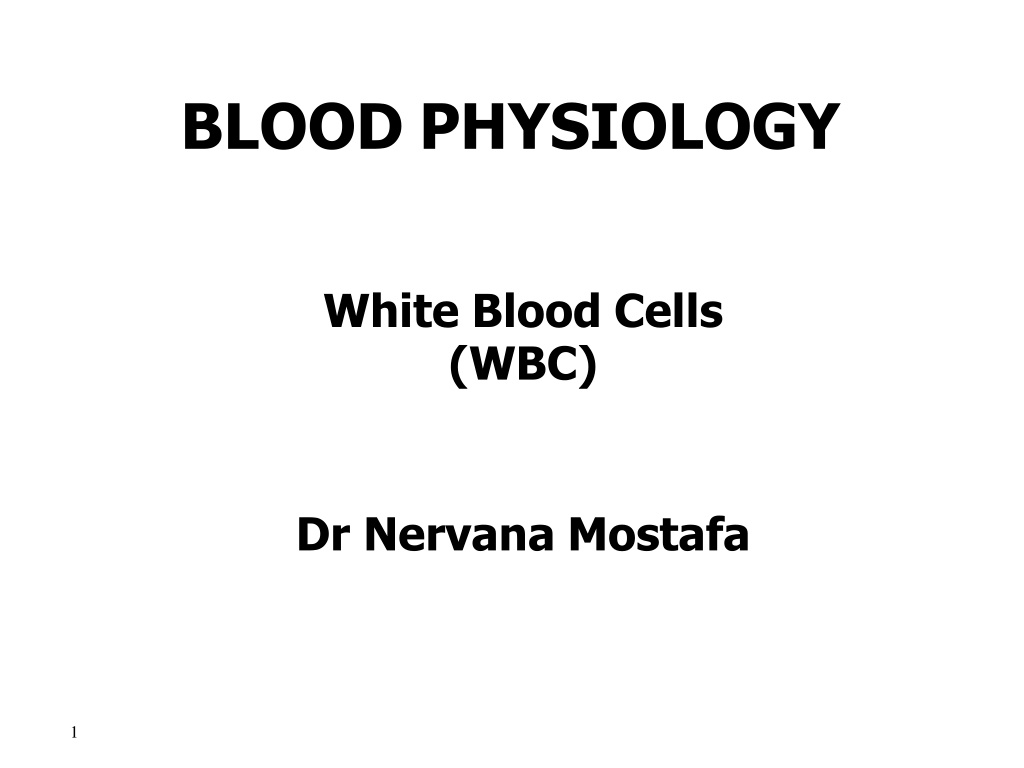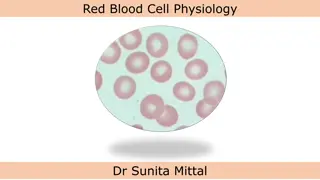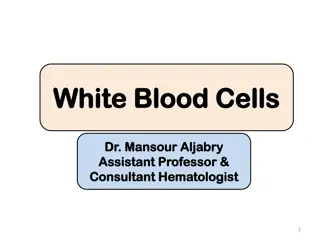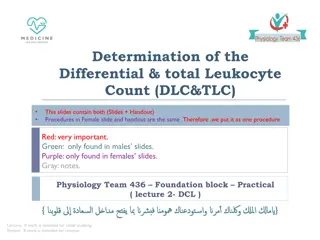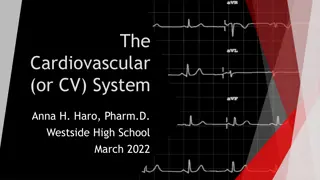Understanding White Blood Cell Physiology and Function
Explore the formation, maturation, and functions of white blood cells, focusing on eosinophils, basophils, monocytes, and macrophages. Learn about the roles of these cells in immune responses, including phagocytosis, allergic reactions, and defense against parasites. Gain insights into the complex processes of white blood cell development in the bone marrow and their crucial functions in maintaining health and fighting diseases.
Uploaded on Oct 07, 2024 | 0 Views
Download Presentation

Please find below an Image/Link to download the presentation.
The content on the website is provided AS IS for your information and personal use only. It may not be sold, licensed, or shared on other websites without obtaining consent from the author. Download presentation by click this link. If you encounter any issues during the download, it is possible that the publisher has removed the file from their server.
E N D
Presentation Transcript
BLOOD PHYSIOLOGY White Blood Cells (WBC) Dr Nervana Mostafa 1
Lecture content Basophilophils formation, Eosinophils and .1 maturation and function Monocytes and macrophage formation, maturation and function Reticuloendothelial system component and .3 .2 function Lymphocytes formation, maturation and .4 function Leucocytosis, leucopenia and leukemia .5 2
White Blood Cells EOSINOPHILLS & BASOPHILS 3
Formation and Maturation of Eosinophils Formed in Bone Marrow: Stem cells Myeloblast Promyelocytes Eosinophil myelocytes Eosinophil metamyelocytes polymorphnuclear eosinophil (Mature Eosinophil released to blood) .1 .2 .3 .4 4
Eosinophil Function Phagocytosis High eosinophil count: Parasitic (hook worm, ascaris, bilharzia) Allergic (asthma, rhinitis, drug reaction) Eosinophil attach themselves to parasites and releases substances (hydrolytic anzymes, superoxide) to kill it 5
Formation and Maturation of Basophils Formed in Bone Marrow Stem cells Myeloblast Promyelocytes Basophil myelocytes Polymorphnuclear Basophil (Mature Basophils released to blood) .1 .2 .3 6
Basophils Similar to mast cells both secrets: Heparin to prevent clotting, Histamine , bradykinin & serotinin contribute to inflammation response The release of those substances cause local and vascular reactions characteristic of allergic manifestation 7
White Blood Cells MONOCYTES & MACROPHAGES 8
Monocytes and Macrophages Formed in Bone Marrow .1 Stem cell monoblast promonocyte mature monocytes released into blood Stay for 10-20 hours in circulation Then leave blood to tissues transforming into larger .2 .3 cells macrophage, Macrophage life span is longer upto few months .4 9
Function of Monocytes and Macrophages Macrophages are a powerful phagocytic cells; first line of defense Functions: anti-inflamatory Ingest up to 100 bacteria, Ingest larger particles as old RBC Get rid of waste and survive Directly: phygocytosis of bacteria, dead cells Indirectly cooperating with lymphocytes by recognizing foreign body (take in foreign body process it and present it to lymphocytes) 10
Indirect anti-inflammatory 12 Dr Sitelbanat 2011
Reticuloendothelialsystem Consist of: Monocytes Macrophage Endothelial cells (bone marrow, spleen, lymph node) Located in all tissues especially: skin (histocytes), liver (kupffer), spleen, bone marrow, lymph nodes, lung 13
Functions of Reticuloendothelial system Phagocytosis: Bacterial, dead cells, .1 foreign particles Breakdown of Hb .2 .3 Immune function: processing antigen and antibodies production (indirect) Storage of iron .4 14
White Blood Cells LYMPHOCYTES 15
Lymphocytes Formation and Maturation Formed in bone marrow, thymus, lymphoid .1 tissues Stem cell (thymus, lymphoid tissue & bone marrow) lymphoblast intermediate pyronophilic blast cell lymphocytes Life Span Of Lymphocytes range from weeks to months according to its type .2 .3 16
Function and types LYMPHOCYTES Function: Types: .1Thymus dependent (T-lymphocytes) .2Thymus (B-lymphocytes) independent 17
T-Lymphocytes (Thymus dependent) Formed in bone marrow or lymphoid tissue migrate to thymus for maturation Life spans 100-130 days. Circulate between blood, tissues, lymph. Types of T-lymphocytes T-helper T-cytotoxic Natural killer Functions Cellular immunity (graft rejection delyed hypersensitivity.) Role in antibody secretion. 18
B- Lymphocytes (thymus-independents) First discovered in Bird Bursa Formed in: Bone marrow, germinal layer of lymph node, red pulp of spleen Life span 2-7 days It transforms into largeplasma cell (produce antibody) Function: Humoral immunity. Stimulated by antigen transforming 19
Leucocytosis Increased WBC Physiological Diurnal morning evening After physical exercise Stress or Adrenaline injection Disease Bacterial infection (tonsillitis, Appendicitis) Worm infection 20
Leucopenia WBC Causes; 1- malnutrition. 2- typhoid fever. 3- drugs. 4- B12 & folic acid 5- radiation 21
Leukaemia Cancer of white cells due to chromosomal abnormality caused by chemicals, radiation, and viruses. WBC more than 50x103 Types of leukaemia Myeloblast leukaemia myeloid cells Lymphoblast leukaemia lymphocytic cells Acute or chronic onset Accompanied with anaemia, bleeding 22
Objectives At the end of this lecture student should be able to: Describe Esinophils formation and .1 functions Describe Basophils formation and .2 functions .3 Describe Monocytes and macrophage formation and functions. Describe Reticuloendothelial componants .4 and functions 23
Objectives At the end of this lecture student should be able to: 5. Describe lymphocytes formation and maturation. 6.Describe the functions of the different types of lymphocytes. 7. Recognise leucocytosis and leucopenia. 8. Recognize type of leukaemia 24
